Analyzing Health Services for Aboriginal Australians
VerifiedAdded on 2021/02/21
|8
|1843
|119
Literature Review
AI Summary
This literature review critically analyzes the impact of health services provided to Australian Aboriginal and Torres Strait Islander peoples. It examines the background of health disparities, aims to determine various health services, their quality, and the impact of segregation policies. The review synthesizes findings from several studies, including those by Schultz & Cairney (2017), Sibthorpe et al. (2018), and Gardner et al. (2018), highlighting issues such as inadequate resources, unequal access, and the influence of historical policies. Key themes include the lower life expectancy, health disparities, the role of education, and the impact of segregation. The review also addresses the importance of culturally appropriate care, community-controlled health services, and the need for policy frameworks to improve health outcomes. The conclusion emphasizes the persistent inequality in health service access and its adverse effects on Indigenous communities.

Literature review
Paraphrase This Document
Need a fresh take? Get an instant paraphrase of this document with our AI Paraphraser
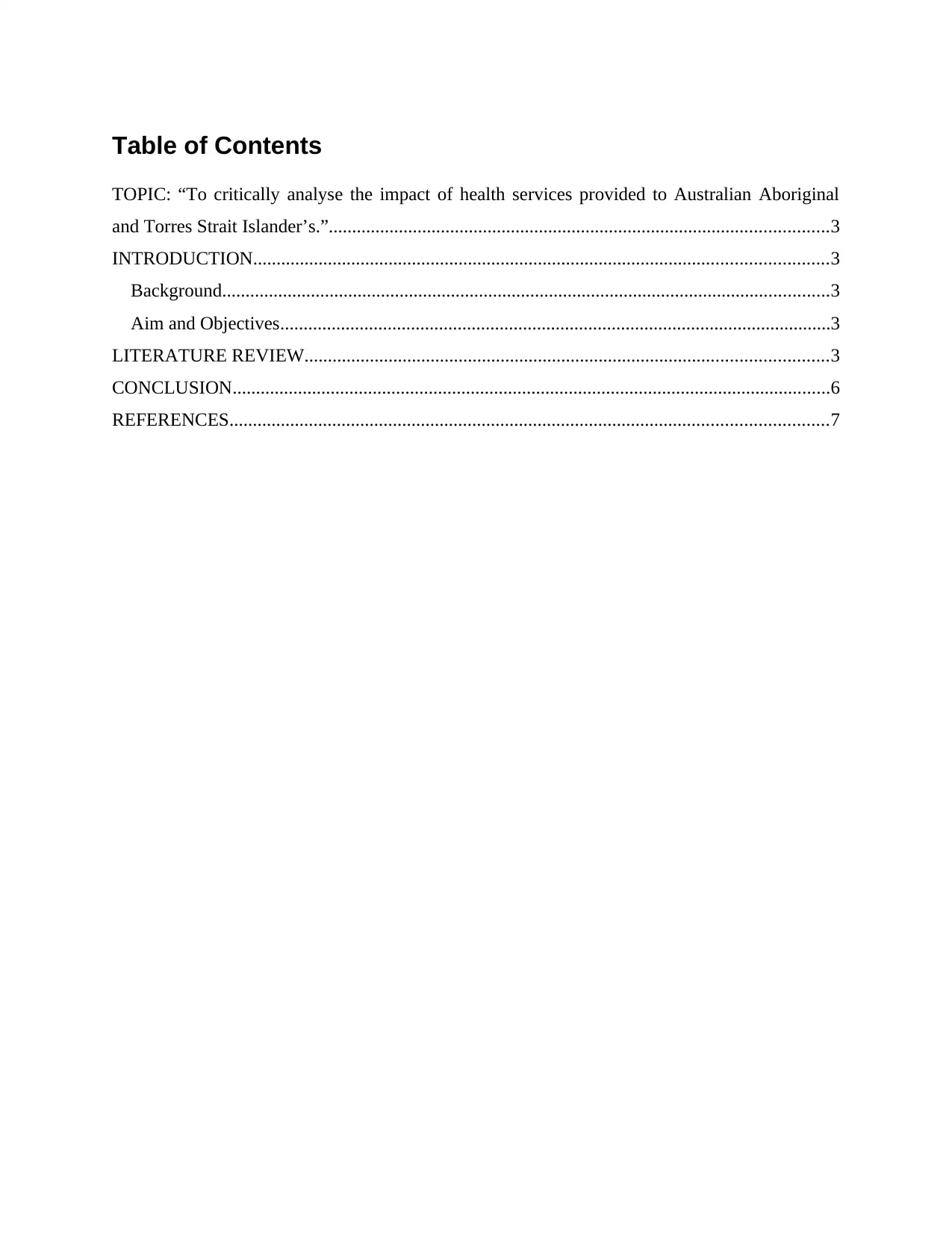
Table of Contents
TOPIC: “To critically analyse the impact of health services provided to Australian Aboriginal
and Torres Strait Islander’s.”...........................................................................................................3
INTRODUCTION...........................................................................................................................3
Background..................................................................................................................................3
Aim and Objectives......................................................................................................................3
LITERATURE REVIEW................................................................................................................3
CONCLUSION................................................................................................................................6
REFERENCES................................................................................................................................7
TOPIC: “To critically analyse the impact of health services provided to Australian Aboriginal
and Torres Strait Islander’s.”...........................................................................................................3
INTRODUCTION...........................................................................................................................3
Background..................................................................................................................................3
Aim and Objectives......................................................................................................................3
LITERATURE REVIEW................................................................................................................3
CONCLUSION................................................................................................................................6
REFERENCES................................................................................................................................7
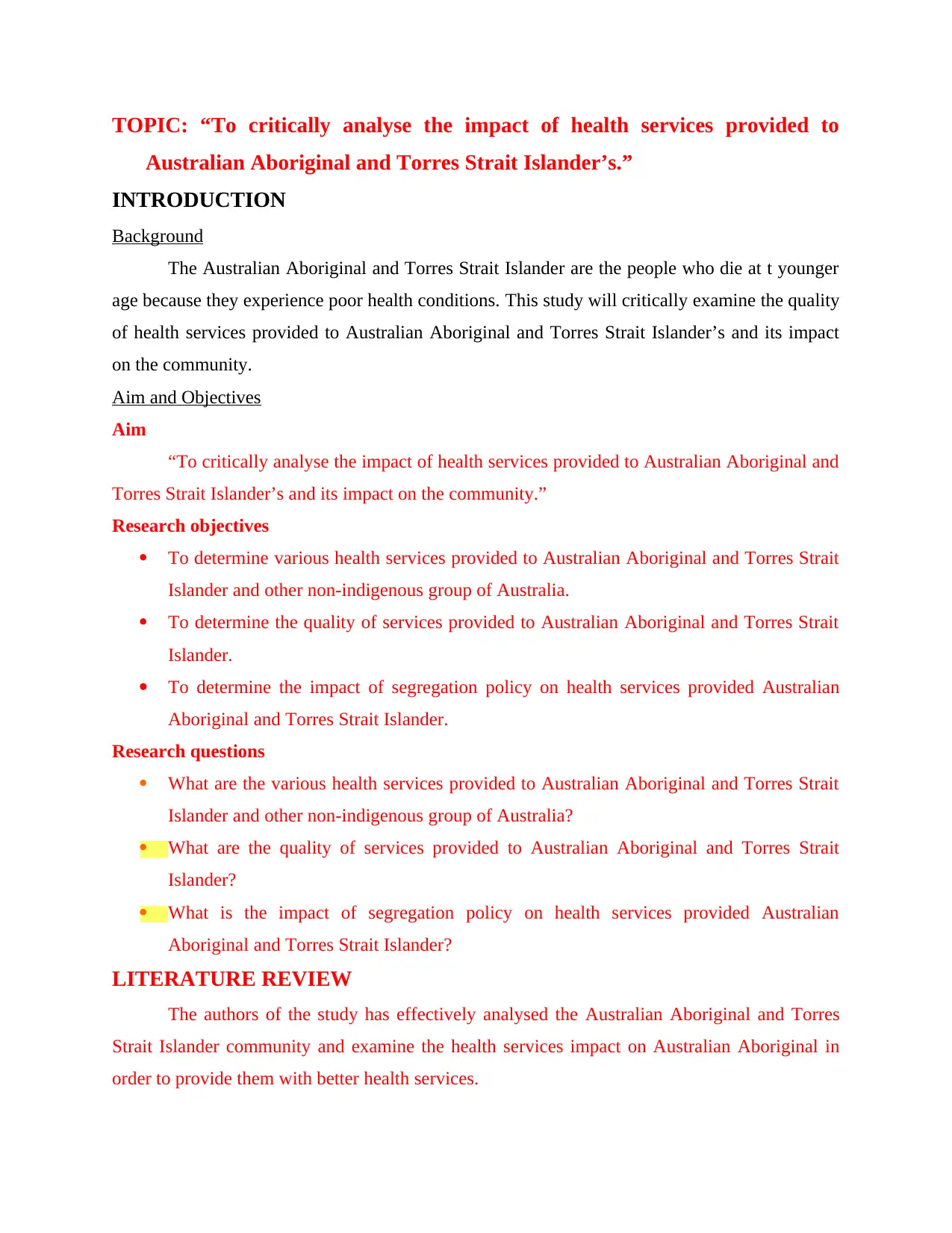
TOPIC: “To critically analyse the impact of health services provided to
Australian Aboriginal and Torres Strait Islander’s.”
INTRODUCTION
Background
The Australian Aboriginal and Torres Strait Islander are the people who die at t younger
age because they experience poor health conditions. This study will critically examine the quality
of health services provided to Australian Aboriginal and Torres Strait Islander’s and its impact
on the community.
Aim and Objectives
Aim
“To critically analyse the impact of health services provided to Australian Aboriginal and
Torres Strait Islander’s and its impact on the community.”
Research objectives
To determine various health services provided to Australian Aboriginal and Torres Strait
Islander and other non-indigenous group of Australia.
To determine the quality of services provided to Australian Aboriginal and Torres Strait
Islander.
To determine the impact of segregation policy on health services provided Australian
Aboriginal and Torres Strait Islander.
Research questions
What are the various health services provided to Australian Aboriginal and Torres Strait
Islander and other non-indigenous group of Australia?
What are the quality of services provided to Australian Aboriginal and Torres Strait
Islander?
What is the impact of segregation policy on health services provided Australian
Aboriginal and Torres Strait Islander?
LITERATURE REVIEW
The authors of the study has effectively analysed the Australian Aboriginal and Torres
Strait Islander community and examine the health services impact on Australian Aboriginal in
order to provide them with better health services.
Australian Aboriginal and Torres Strait Islander’s.”
INTRODUCTION
Background
The Australian Aboriginal and Torres Strait Islander are the people who die at t younger
age because they experience poor health conditions. This study will critically examine the quality
of health services provided to Australian Aboriginal and Torres Strait Islander’s and its impact
on the community.
Aim and Objectives
Aim
“To critically analyse the impact of health services provided to Australian Aboriginal and
Torres Strait Islander’s and its impact on the community.”
Research objectives
To determine various health services provided to Australian Aboriginal and Torres Strait
Islander and other non-indigenous group of Australia.
To determine the quality of services provided to Australian Aboriginal and Torres Strait
Islander.
To determine the impact of segregation policy on health services provided Australian
Aboriginal and Torres Strait Islander.
Research questions
What are the various health services provided to Australian Aboriginal and Torres Strait
Islander and other non-indigenous group of Australia?
What are the quality of services provided to Australian Aboriginal and Torres Strait
Islander?
What is the impact of segregation policy on health services provided Australian
Aboriginal and Torres Strait Islander?
LITERATURE REVIEW
The authors of the study has effectively analysed the Australian Aboriginal and Torres
Strait Islander community and examine the health services impact on Australian Aboriginal in
order to provide them with better health services.
⊘ This is a preview!⊘
Do you want full access?
Subscribe today to unlock all pages.

Trusted by 1+ million students worldwide
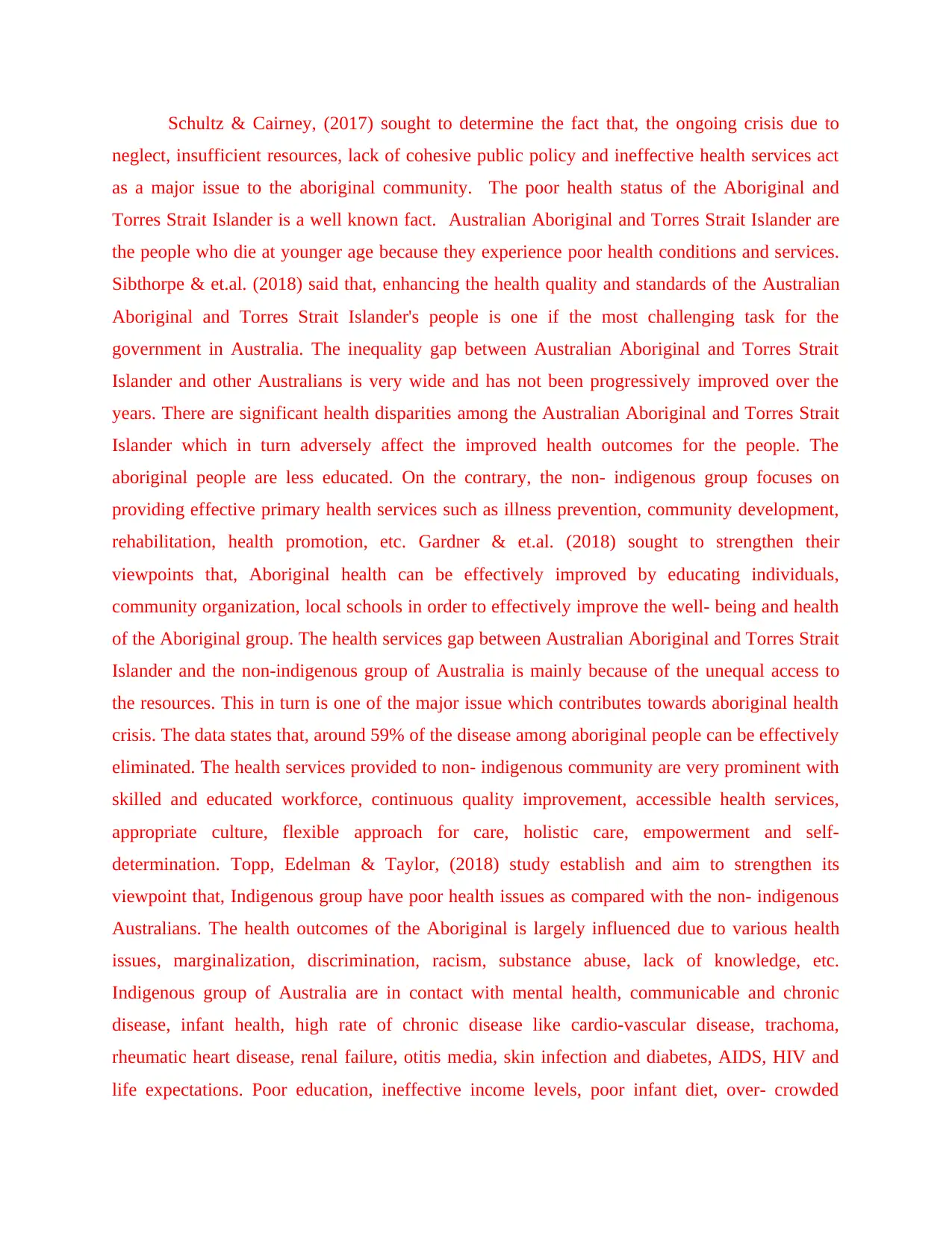
Schultz & Cairney, (2017) sought to determine the fact that, the ongoing crisis due to
neglect, insufficient resources, lack of cohesive public policy and ineffective health services act
as a major issue to the aboriginal community. The poor health status of the Aboriginal and
Torres Strait Islander is a well known fact. Australian Aboriginal and Torres Strait Islander are
the people who die at younger age because they experience poor health conditions and services.
Sibthorpe & et.al. (2018) said that, enhancing the health quality and standards of the Australian
Aboriginal and Torres Strait Islander's people is one if the most challenging task for the
government in Australia. The inequality gap between Australian Aboriginal and Torres Strait
Islander and other Australians is very wide and has not been progressively improved over the
years. There are significant health disparities among the Australian Aboriginal and Torres Strait
Islander which in turn adversely affect the improved health outcomes for the people. The
aboriginal people are less educated. On the contrary, the non- indigenous group focuses on
providing effective primary health services such as illness prevention, community development,
rehabilitation, health promotion, etc. Gardner & et.al. (2018) sought to strengthen their
viewpoints that, Aboriginal health can be effectively improved by educating individuals,
community organization, local schools in order to effectively improve the well- being and health
of the Aboriginal group. The health services gap between Australian Aboriginal and Torres Strait
Islander and the non-indigenous group of Australia is mainly because of the unequal access to
the resources. This in turn is one of the major issue which contributes towards aboriginal health
crisis. The data states that, around 59% of the disease among aboriginal people can be effectively
eliminated. The health services provided to non- indigenous community are very prominent with
skilled and educated workforce, continuous quality improvement, accessible health services,
appropriate culture, flexible approach for care, holistic care, empowerment and self-
determination. Topp, Edelman & Taylor, (2018) study establish and aim to strengthen its
viewpoint that, Indigenous group have poor health issues as compared with the non- indigenous
Australians. The health outcomes of the Aboriginal is largely influenced due to various health
issues, marginalization, discrimination, racism, substance abuse, lack of knowledge, etc.
Indigenous group of Australia are in contact with mental health, communicable and chronic
disease, infant health, high rate of chronic disease like cardio-vascular disease, trachoma,
rheumatic heart disease, renal failure, otitis media, skin infection and diabetes, AIDS, HIV and
life expectations. Poor education, ineffective income levels, poor infant diet, over- crowded
neglect, insufficient resources, lack of cohesive public policy and ineffective health services act
as a major issue to the aboriginal community. The poor health status of the Aboriginal and
Torres Strait Islander is a well known fact. Australian Aboriginal and Torres Strait Islander are
the people who die at younger age because they experience poor health conditions and services.
Sibthorpe & et.al. (2018) said that, enhancing the health quality and standards of the Australian
Aboriginal and Torres Strait Islander's people is one if the most challenging task for the
government in Australia. The inequality gap between Australian Aboriginal and Torres Strait
Islander and other Australians is very wide and has not been progressively improved over the
years. There are significant health disparities among the Australian Aboriginal and Torres Strait
Islander which in turn adversely affect the improved health outcomes for the people. The
aboriginal people are less educated. On the contrary, the non- indigenous group focuses on
providing effective primary health services such as illness prevention, community development,
rehabilitation, health promotion, etc. Gardner & et.al. (2018) sought to strengthen their
viewpoints that, Aboriginal health can be effectively improved by educating individuals,
community organization, local schools in order to effectively improve the well- being and health
of the Aboriginal group. The health services gap between Australian Aboriginal and Torres Strait
Islander and the non-indigenous group of Australia is mainly because of the unequal access to
the resources. This in turn is one of the major issue which contributes towards aboriginal health
crisis. The data states that, around 59% of the disease among aboriginal people can be effectively
eliminated. The health services provided to non- indigenous community are very prominent with
skilled and educated workforce, continuous quality improvement, accessible health services,
appropriate culture, flexible approach for care, holistic care, empowerment and self-
determination. Topp, Edelman & Taylor, (2018) study establish and aim to strengthen its
viewpoint that, Indigenous group have poor health issues as compared with the non- indigenous
Australians. The health outcomes of the Aboriginal is largely influenced due to various health
issues, marginalization, discrimination, racism, substance abuse, lack of knowledge, etc.
Indigenous group of Australia are in contact with mental health, communicable and chronic
disease, infant health, high rate of chronic disease like cardio-vascular disease, trachoma,
rheumatic heart disease, renal failure, otitis media, skin infection and diabetes, AIDS, HIV and
life expectations. Poor education, ineffective income levels, poor infant diet, over- crowded
Paraphrase This Document
Need a fresh take? Get an instant paraphrase of this document with our AI Paraphraser
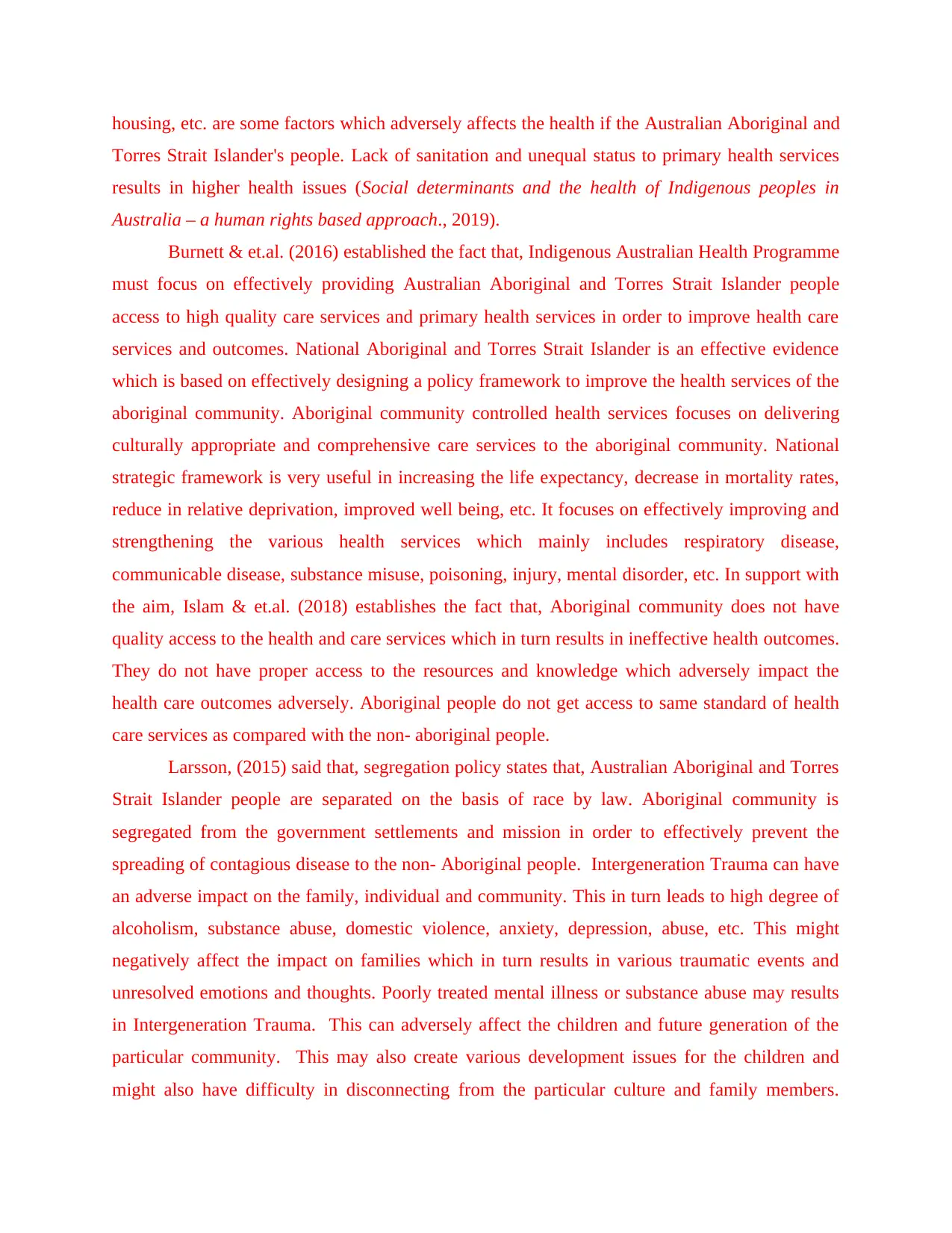
housing, etc. are some factors which adversely affects the health if the Australian Aboriginal and
Torres Strait Islander's people. Lack of sanitation and unequal status to primary health services
results in higher health issues (Social determinants and the health of Indigenous peoples in
Australia – a human rights based approach., 2019).
Burnett & et.al. (2016) established the fact that, Indigenous Australian Health Programme
must focus on effectively providing Australian Aboriginal and Torres Strait Islander people
access to high quality care services and primary health services in order to improve health care
services and outcomes. National Aboriginal and Torres Strait Islander is an effective evidence
which is based on effectively designing a policy framework to improve the health services of the
aboriginal community. Aboriginal community controlled health services focuses on delivering
culturally appropriate and comprehensive care services to the aboriginal community. National
strategic framework is very useful in increasing the life expectancy, decrease in mortality rates,
reduce in relative deprivation, improved well being, etc. It focuses on effectively improving and
strengthening the various health services which mainly includes respiratory disease,
communicable disease, substance misuse, poisoning, injury, mental disorder, etc. In support with
the aim, Islam & et.al. (2018) establishes the fact that, Aboriginal community does not have
quality access to the health and care services which in turn results in ineffective health outcomes.
They do not have proper access to the resources and knowledge which adversely impact the
health care outcomes adversely. Aboriginal people do not get access to same standard of health
care services as compared with the non- aboriginal people.
Larsson, (2015) said that, segregation policy states that, Australian Aboriginal and Torres
Strait Islander people are separated on the basis of race by law. Aboriginal community is
segregated from the government settlements and mission in order to effectively prevent the
spreading of contagious disease to the non- Aboriginal people. Intergeneration Trauma can have
an adverse impact on the family, individual and community. This in turn leads to high degree of
alcoholism, substance abuse, domestic violence, anxiety, depression, abuse, etc. This might
negatively affect the impact on families which in turn results in various traumatic events and
unresolved emotions and thoughts. Poorly treated mental illness or substance abuse may results
in Intergeneration Trauma. This can adversely affect the children and future generation of the
particular community. This may also create various development issues for the children and
might also have difficulty in disconnecting from the particular culture and family members.
Torres Strait Islander's people. Lack of sanitation and unequal status to primary health services
results in higher health issues (Social determinants and the health of Indigenous peoples in
Australia – a human rights based approach., 2019).
Burnett & et.al. (2016) established the fact that, Indigenous Australian Health Programme
must focus on effectively providing Australian Aboriginal and Torres Strait Islander people
access to high quality care services and primary health services in order to improve health care
services and outcomes. National Aboriginal and Torres Strait Islander is an effective evidence
which is based on effectively designing a policy framework to improve the health services of the
aboriginal community. Aboriginal community controlled health services focuses on delivering
culturally appropriate and comprehensive care services to the aboriginal community. National
strategic framework is very useful in increasing the life expectancy, decrease in mortality rates,
reduce in relative deprivation, improved well being, etc. It focuses on effectively improving and
strengthening the various health services which mainly includes respiratory disease,
communicable disease, substance misuse, poisoning, injury, mental disorder, etc. In support with
the aim, Islam & et.al. (2018) establishes the fact that, Aboriginal community does not have
quality access to the health and care services which in turn results in ineffective health outcomes.
They do not have proper access to the resources and knowledge which adversely impact the
health care outcomes adversely. Aboriginal people do not get access to same standard of health
care services as compared with the non- aboriginal people.
Larsson, (2015) said that, segregation policy states that, Australian Aboriginal and Torres
Strait Islander people are separated on the basis of race by law. Aboriginal community is
segregated from the government settlements and mission in order to effectively prevent the
spreading of contagious disease to the non- Aboriginal people. Intergeneration Trauma can have
an adverse impact on the family, individual and community. This in turn leads to high degree of
alcoholism, substance abuse, domestic violence, anxiety, depression, abuse, etc. This might
negatively affect the impact on families which in turn results in various traumatic events and
unresolved emotions and thoughts. Poorly treated mental illness or substance abuse may results
in Intergeneration Trauma. This can adversely affect the children and future generation of the
particular community. This may also create various development issues for the children and
might also have difficulty in disconnecting from the particular culture and family members.
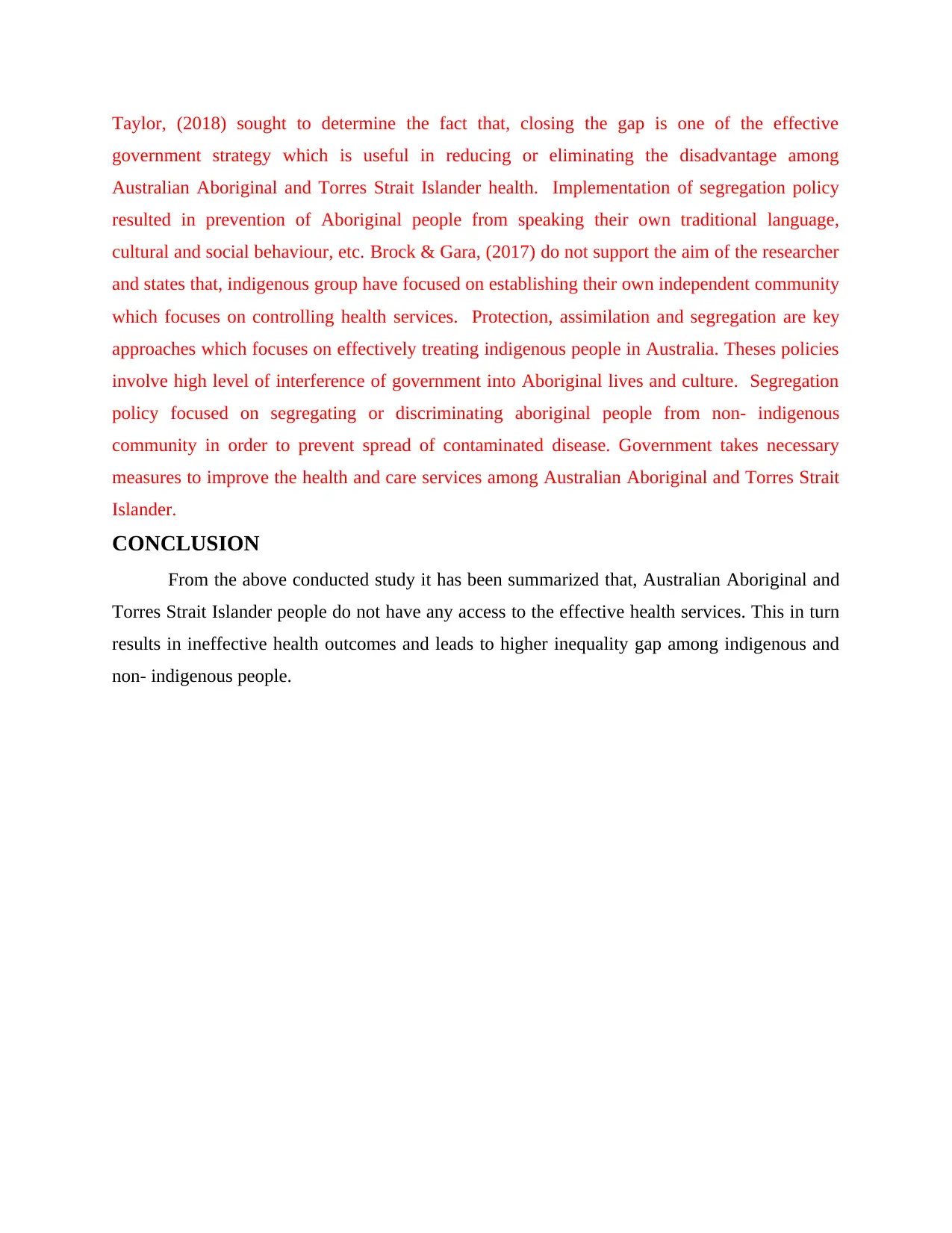
Taylor, (2018) sought to determine the fact that, closing the gap is one of the effective
government strategy which is useful in reducing or eliminating the disadvantage among
Australian Aboriginal and Torres Strait Islander health. Implementation of segregation policy
resulted in prevention of Aboriginal people from speaking their own traditional language,
cultural and social behaviour, etc. Brock & Gara, (2017) do not support the aim of the researcher
and states that, indigenous group have focused on establishing their own independent community
which focuses on controlling health services. Protection, assimilation and segregation are key
approaches which focuses on effectively treating indigenous people in Australia. Theses policies
involve high level of interference of government into Aboriginal lives and culture. Segregation
policy focused on segregating or discriminating aboriginal people from non- indigenous
community in order to prevent spread of contaminated disease. Government takes necessary
measures to improve the health and care services among Australian Aboriginal and Torres Strait
Islander.
CONCLUSION
From the above conducted study it has been summarized that, Australian Aboriginal and
Torres Strait Islander people do not have any access to the effective health services. This in turn
results in ineffective health outcomes and leads to higher inequality gap among indigenous and
non- indigenous people.
government strategy which is useful in reducing or eliminating the disadvantage among
Australian Aboriginal and Torres Strait Islander health. Implementation of segregation policy
resulted in prevention of Aboriginal people from speaking their own traditional language,
cultural and social behaviour, etc. Brock & Gara, (2017) do not support the aim of the researcher
and states that, indigenous group have focused on establishing their own independent community
which focuses on controlling health services. Protection, assimilation and segregation are key
approaches which focuses on effectively treating indigenous people in Australia. Theses policies
involve high level of interference of government into Aboriginal lives and culture. Segregation
policy focused on segregating or discriminating aboriginal people from non- indigenous
community in order to prevent spread of contaminated disease. Government takes necessary
measures to improve the health and care services among Australian Aboriginal and Torres Strait
Islander.
CONCLUSION
From the above conducted study it has been summarized that, Australian Aboriginal and
Torres Strait Islander people do not have any access to the effective health services. This in turn
results in ineffective health outcomes and leads to higher inequality gap among indigenous and
non- indigenous people.
⊘ This is a preview!⊘
Do you want full access?
Subscribe today to unlock all pages.

Trusted by 1+ million students worldwide

REFERENCES
Books and journals
Brock, P., & Gara, T. (2017). From segregation to self-determination in the twentieth century.
Burnett, A. M & et.al. (2016). Delivery of eye and Vision services in aboriginal and Torres strait
islander Primary healthcare centers. Frontiers in public health.4. 276.
Gardner, K & et.al. (2018). Implementation of continuous quality improvement in Aboriginal
and Torres Strait Islander primary health care in Australia: a scoping systematic
review. BMC health services research.18(1). 541.
Islam, M. M & et.al. (2018). Standardised alcohol screening in primary health care services
targeting Aboriginal and Torres Strait Islander peoples in Australia. Addiction science &
clinical practice.13(1). 5.
Larsson, P. (2015). Racial segregation. Eugenics Archives.
Schultz, R., & Cairney, S. (2017). Caring for country and the health of Aboriginal and Torres
Strait Islander Australians. Medical Journal of Australia.207(1). 8-10.
Sibthorpe, B & et.al. (2018). Impacts of continuous quality improvement in Aboriginal and
Torres Strait islander primary health care in Australia: A scoping systematic
review. Journal of health organization and management.32(4). 545-571.
Taylor, J. (2018). Indigenous employment and job segregation in the Northern Territory labour
market. Canberra, ACT: Centre for Aboriginal Economic Policy Research (CAEPR), The
Australian National University.
Topp, S. M., Edelman, A., & Taylor, S. (2018). “We are everything to everyone”: a systematic
review of factors influencing the accountability relationships of Aboriginal and Torres
Strait Islander health workers (AHWs) in the Australian health system. International
journal for equity in health.17(1). 67.
Online
Social determinants and the health of Indigenous peoples in Australia – a human rights based
approach. 2019. [Online]. Available through:
<https://www.humanrights.gov.au/about/news/speeches/social-determinants-and-health-
indigenous-peoples-australia-human-rights-based>
Books and journals
Brock, P., & Gara, T. (2017). From segregation to self-determination in the twentieth century.
Burnett, A. M & et.al. (2016). Delivery of eye and Vision services in aboriginal and Torres strait
islander Primary healthcare centers. Frontiers in public health.4. 276.
Gardner, K & et.al. (2018). Implementation of continuous quality improvement in Aboriginal
and Torres Strait Islander primary health care in Australia: a scoping systematic
review. BMC health services research.18(1). 541.
Islam, M. M & et.al. (2018). Standardised alcohol screening in primary health care services
targeting Aboriginal and Torres Strait Islander peoples in Australia. Addiction science &
clinical practice.13(1). 5.
Larsson, P. (2015). Racial segregation. Eugenics Archives.
Schultz, R., & Cairney, S. (2017). Caring for country and the health of Aboriginal and Torres
Strait Islander Australians. Medical Journal of Australia.207(1). 8-10.
Sibthorpe, B & et.al. (2018). Impacts of continuous quality improvement in Aboriginal and
Torres Strait islander primary health care in Australia: A scoping systematic
review. Journal of health organization and management.32(4). 545-571.
Taylor, J. (2018). Indigenous employment and job segregation in the Northern Territory labour
market. Canberra, ACT: Centre for Aboriginal Economic Policy Research (CAEPR), The
Australian National University.
Topp, S. M., Edelman, A., & Taylor, S. (2018). “We are everything to everyone”: a systematic
review of factors influencing the accountability relationships of Aboriginal and Torres
Strait Islander health workers (AHWs) in the Australian health system. International
journal for equity in health.17(1). 67.
Online
Social determinants and the health of Indigenous peoples in Australia – a human rights based
approach. 2019. [Online]. Available through:
<https://www.humanrights.gov.au/about/news/speeches/social-determinants-and-health-
indigenous-peoples-australia-human-rights-based>
Paraphrase This Document
Need a fresh take? Get an instant paraphrase of this document with our AI Paraphraser

1 out of 8
Related Documents
Your All-in-One AI-Powered Toolkit for Academic Success.
+13062052269
info@desklib.com
Available 24*7 on WhatsApp / Email
![[object Object]](/_next/static/media/star-bottom.7253800d.svg)
Unlock your academic potential
Copyright © 2020–2025 A2Z Services. All Rights Reserved. Developed and managed by ZUCOL.





